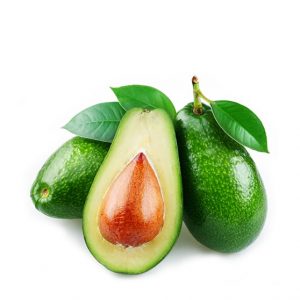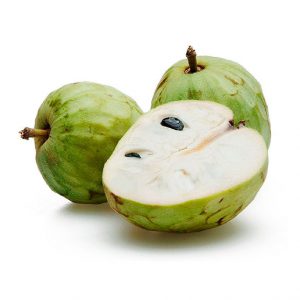Apricot
Fruit of 5 to 9 centimetres in diameter, with rounded shape and a groove that divides it in the middle lengthwise. The apricot varies in colour - usually orange - and size according to variety, but all have a velvety skin and a thick, juicy yellow flesh. The flavours, as well as their appearance, vary according to the type of apricot, so some have a sweet taste and some more sweet and sour.
Varieties: Bulida, Mauricio, Valencianos, Real Fino, Moniquí etc.
Seasonality: From April to October
Avocado
Shape: pear-shaped, it contains a single light colour round seed of 24 cm long that appears covered with a thin brown woody layer. Size and weight:. Although there are varieties that weigh 100 grams and others that can reach 2 kilograms, the most commercialized tend to measure 10 to 13 centimetres, weighing 150 to 350 grams. Colour: crust, thick and hard, with roughness, has a green colour that varies in intensity depending on the variety. Meat is creamy, oily, creamy or pale green to yellowish white, very similar to butter. Flavour: The flavour of the meat is a mix of the cream that you get of walnut and hazelnut usually made by hand, and it is a very delicate fruit. Fruits do not ripen on the tree, but they do so once they have been picked up, at which point they undergo intense respiratory activity (ethylene deactivated), so storage for long periods is a challenge. Respiratory activity is said to differ depending on variety and maturity, environmental conditions and storage methods.
Varieties: Exporter by Avocitrus: Bacon, Strong and Hass.
Seasonality: From October to February with luck.
Cherimoya
It has a heart shape, oval or conical, being able to measure between 7.5 cm and 12.5 cm in length and weighing between 150 gr. and 1 kg. The skin of cherimoya is green, very fine and fragile, with scaly shapes. The pulp is fleshy, white and very sweet. It contains a multitude of black seeds inside.
Varieties: The most commercialized varieties are green, large or small, and gray, oxidized appearance. We can also find red or pink that are larger.
Seasonality: The ideal time to consume this fruit is between the months of October to December, being able to find it punctually also in the months of September and January.
Flat Peach
Flat peaches have a shape very similar to the peach with which they share their velvety skin and its colour. Its shape is flatter, being a smaller fruit. Its flavour is sweeter than the peach.
Varieties: There are different varieties: white pulp with or without greenish or reddish veins, yellow pulp, totally or partially detached from the seed.
Seasonality: From the end of May until the end of September we will find them fresh in our markets.
Lemons
Almost round, it has a intense yellow colour and a smooth and strong skin. Its pulp is of a whitish yellowish colour divided in segments with much juice and with a recognized acid flavour. When you cut it from the tree, it gives off a unique aroma.
Varieties: We find a multitude of varieties depending on the colour and the type of skin, for example: Fine, Primofiori or Verna. The last two are the most commercialized in Spain, both with yellow colour and good size, with thick skin and very aromatic.
Seasonality: We can find fresh lemons all year round, although we can find just Redrojo in summer time, which is green skin.
Limes
Description: Shape similar to the lemon but smaller, with green or yellow bark and whose pulp is divided into segments full of juice and without seeds. The skin is soft and of little thickness compared to the skin of other citrus fruits like oranges or lemons. Its taste is sour.
Varieties: Among the best known varieties are: Lima kaffir, acid lime or Galician lime, Persian lime or Tahiti lime, lime chichona or lime bergamot, lemonsón or lemon from Rome, sweet Indian lime or lime from Palestine, lime Canton or lime rangpur, the long lime, the desert lime
Seasonality: They are available in our markets throughout the year, when Avocitrus does not have from Spain, we import from Colombia to always offer the best product.
Loquats
It has oval shape and rather small size. Its fine skin is orange as well as the flesh. Inside it houses a thick brown seed. Its flavour is sweet with a slight acid touch.
Varieties: We know the following varieties: Japanese, Algar, Chinese, Tanaka, Peluche and Golden Nuget. This last one is cultivated in zones of Malaga and Granada and it picks up big fruits, almost round, and more acidic flavour.
Seasonality: The best time to consume it is during the months of April and May, although we can also find them in March and June.
Mandarin
Round fruit slightly flattened, about 4-7 cm in length and between 5 and 8 cm in diameter. His skin, smooth and bright, varies from yellowish green to orange red, the most common being orange. The pulp, divided into segments full of juice, is orange, fibrous texture and bittersweet flavour.
Varieties: The varieties that we can find in the Spanish markets are: Satsumas (Okitsu and Clauselina), Clementines (Fina, Clemenules and Hernandina) and Hybrids (Fortune and Ortanique).
Seasonality: We can find them during the months of November to March.
Mango
Oval or spheroidal, it measures between 5 and 20 cm in length and its weight is around 400 gr. The skin is thin and inedible, with varying colours between yellow and red. The pulp, which grows around the fibrous bone, is fleshy, almost orange in colour, very juicy and with an exotically sweet flavour.
Varieties: We find varieties depending on skin colour and size. Among them we emphasize Keith, Kent, Irwin and Tommy.
Seasonality: Mango harvesting is from August to November, and can be extended to July as well.
Nectarine
Peach-like round fruit, its skin is not fluffy but smooth as the plum and can be consumed without peeling or peeling. It also differs from the peach by its inner bone that is not attached to the pulp, it is free. There are nectarines of yellow pulp and white pulp. Its flesh is fleshy, sweet and juicy with a crunchy touch.
Varieties: There are a large number of varieties, including the yellow pulp (Venus, Fairlane, Flamensky, Big-Top, Red Diamond, Red-Jim, Albarred) and white pulp (Silver Late, Snow Queen , Early Giant, Flavor-Giant, Queen-Giant, Silver-Romme, Caldesi 2000-2020)
Seasonality: The harvesting time of nectarine is during the month of May in the Northern Hemisphere, although it can be found in markets throughout the year as it is grown in many countries of the world.













